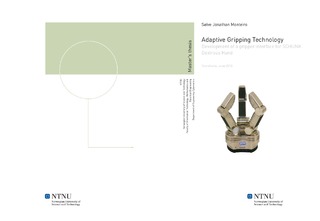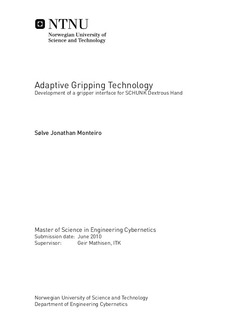| dc.description.abstract | The use of robotic grippers offers huge potential benefits in industrial settings. The more advanced a gripper is, the more uses it can have, thus offering large economic benefits. On the other hand, the more complex a gripper is, the more advanced its control system needs to be, in order to control it effectively and safely. This thesis will focus on controlling SCHUNK Dextrous Hand (SDH), a 3-fingered robotic gripper with 7 degrees of freedom and tactile sensors in the fingers. By creating a real-time control system the sensors in the fingers can be used to make a feedback loop that controls the fingers. This is the basis for creating an adaptive gripper that can grip objects of unknown shape, size or position. This control system in combination with a controller for a robotic manipulator arm lets the gripper attempt to grip objects even if they are out of reach. By passing requests up to an overall control system, the gripper can request a translation to a position that gives it a better chance at performing a successful grip on the targeted object. In this project, the controller for the gripper is created, and the communication to and from the manipulator control system is replaced with a simple user-interface. This user interface offers a way of testing the complete system without the use of a manipulator arm. The translations from the gripper is read out, and the target object is moved by hand, in the opposite direction. This solution offers a simple way to expand the system to include the manipulator and its control system in later editions. Initial experiments were successful, with the gripper successfully able to pick up different objects. An apple, an empty soda can (both upright and lying down) and a chocolate egg were all picked up and held firmly without damaging the object. Complications arose with regards to the sensitivity of the sensors. They were generally unable to register any pressure when the fingers came in contact with lighter objects, and had to push the objects against the other two fingers. Another problem that arose was the stability of the application created. The program was based on multi-threading, and real-time sensor analysis. The application crashing did cause some objects to be damaged in the experiments, as the application logic could not halt the fingers despite pressure being registered. Future work should focus on restructuring the application logic to improve the stability, and the control system for the manipulator arm. | nb_NO |

